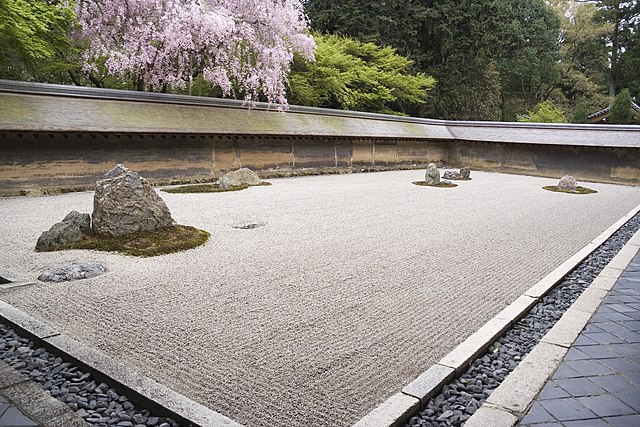It seems there might be a slight misunderstanding in your query. Ryōan-ji (龍安寺) is a Zen Buddhist temple located in Kyoto, Japan, known for its famous rock garden rather than “Ryban-ji.” If you were referring to Ryōan-ji, I can certainly provide information about the spiritual and aesthetic elements of the temple’s rock garden.
Ryōan-ji Rock Garden:
1. Minimalist Aesthetics:
- The rock garden at Ryōan-ji is a quintessential example of Japanese Zen aesthetics. It features a meticulously raked gravel bed with 15 rocks of various sizes placed on patches of moss. The simplicity of the design encourages contemplation.

2. Symbolism of the Rocks:
- The arrangement of the rocks is intentional, yet their specific meaning is open to interpretation. Some believe that the 15 rocks represent elements of nature, while others see them as islands in a sea. The arrangement is deliberately asymmetrical.
3. Gravel Ripples:
- The raked gravel around the rocks is meticulously maintained, creating patterns that resemble ripples in water. The act of raking is considered a meditative practice and adds a dynamic element to the garden.
4. Zen Buddhism Influence:
- The rock garden embodies the principles of Zen Buddhism, emphasizing simplicity, mindfulness, and the concept of “wabi-sabi,” which appreciates imperfection and transience.
5. Contemplative Space:
- Visitors are invited to view the rock garden from a wooden veranda, allowing for a quiet and contemplative experience. The design encourages mindfulness and reflection.
6. Seasonal Changes:
- The surrounding landscape, including the adjacent Kyoyochi Pond and the temple’s surrounding gardens, undergoes seasonal changes, enhancing the overall aesthetic experience.
7. Historical Significance:
- Ryōan-ji was originally built in the late 15th century and has since become a UNESCO World Heritage Site. It is considered one of the finest examples of Japanese Zen temple architecture and garden design.
8. Cultural Impact:
- The rock garden at Ryōan-ji has had a significant impact on the worlds of art and design, influencing various artists, architects, and designers worldwide.
9. Visitor Reflection:
- The intentional ambiguity of the rock garden invites visitors to bring their own perspectives and emotions to the experience. Many find solace and inspiration in the simplicity of the design.
Ryōan-ji’s rock garden exemplifies the deep connection between aesthetics, spirituality, and mindfulness in Japanese culture. It continues to be a source of inspiration and contemplation for people from various walks of life. If you were referring to a different concept with “Ryban-ji,” please provide more details, and I’ll do my best to assist you.











